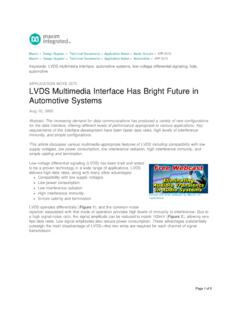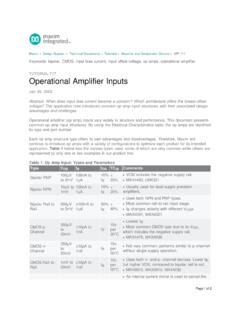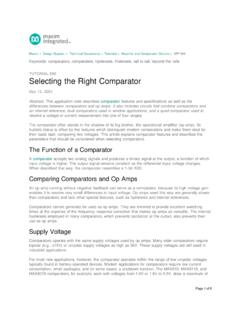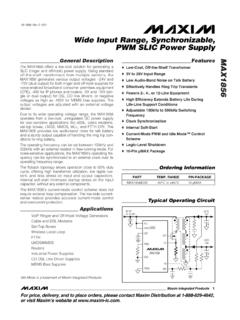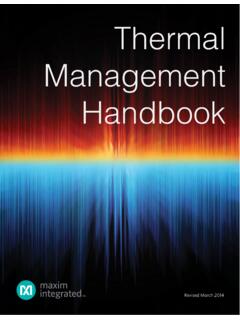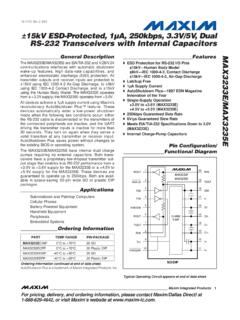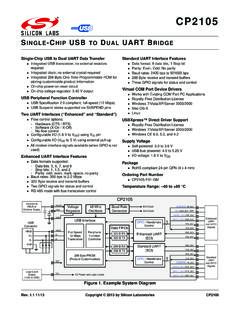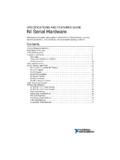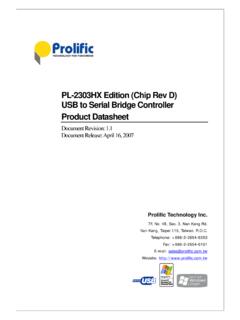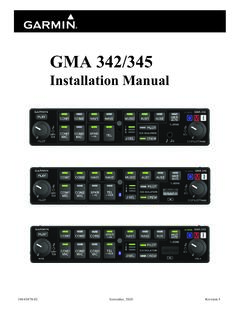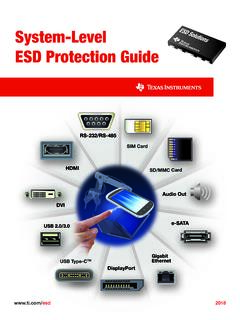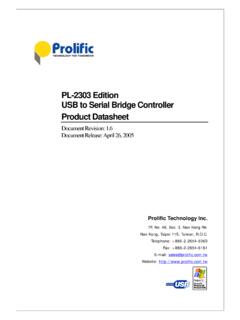Transcription of How Far and How Fast Can You Go with RS-485? - Application ...
1 Keywords: RS485, RS422, RS-485, RS-422, Interface, Protocol, Line Drivers, Differential Line Drivers Application NOTE 3884 HOW FAR AND HOW FAST CAN YOU GO WITHRS-485?Abstract: Designers of industrial datacom systems often ask, What data rates can be reliably achieved overwhat distance, and how? The design trade-off has always been less distance at a higher rate, or greaterdistance at a lower rate. So, the crucial question is: How far can you reliably transmit and receive data at aspecified data rate? The original publishing of this Application note used the MAX3469 to demonstrate RS-485 performance, and that data is still valid.
2 However, Maxim has raised the performance of RS-485 to100 Mbps with the introduction of products such as the MAX22500E. This Application note shows how to gofarther and faster. IntroductionThe various serial-datacom protocols range from RS-232 (EIA/TIA-232) to Gigabit Ethernet, and each protocol suits a particular Application , in all cases you must consider cost and performance ofthe physical (PHY) layer. This article focuses on the RS-485 (EIA/TIA-485) protocol and the applicationsbest suited to that standard. It also shows the ways that you can optimize data rates as a function ofcabling, system design, and component this Application note, we will use the RS nomenclature to refer to the respective ANSI DefinitionsWhat is RS-485?
3 How does it compare to other serial protocols, and for what applications are they bestsuited? The following overview compares the characteristics and capabilities of the RS-485 PHY with thoseof RS-232 and is a standard that originated as a communications guide for modems, printers, and other PC peripherals. It provided a single-ended channel with baud rates up to 20kbps, and later enhanced to 1 Mbps. Other RS-232 specifications include nominal 5V transmit and 3V receive (space/mark) signal levels, 2V common-mode rejection, 2200pF maximum cable load capacitance, 300 maximum driver output resistance, 3k minimum receiver (load) impedance, and 100ft (typical) maximum cable length.
4 RS-232 systems are point-to-point only. Any RS-232 system must accommodate these is a unidirectional, full-duplex standard for electrically noisy industrial environments. It specifies a single driver with multiple receivers. The signal path is differential, and handles bit rates above 50 Mbps. The receivers' common-mode range is 7V, the driver output resistance is 100 maximum, and the receiver input impedance can be as low as 4k .[1]Page 1 of 12 The RS-485 StandardThe original ANSI/EIA/TIA-485-A-1998 standard was approved in March 1998 to address the shortcomings of RS-232 and RS-422.
5 RS-485 is a bidirectional, half-duplex standard featuring multiple "bused" drivers and receivers, in which each driver can relinquish the bus. It meets all RS-422 specifications, but is more robust including, for example, a higher receiver-input impedance and wider common-mode range (-7V to+12V).Receiver input sensitivity is 200mV, which means that to recognize a mark or space, a receiver must see signal levels above +200mV or below -200mV. The minimum receiver input impedance is 12k (called a unit load), and the driver output voltage is minimum, 5V capacity is 32 unit loads, , 32 12k receivers in parallel.
6 Many receivers are designed with a higher input impedance, allowing the number of unit loads on one bus to be higher as well. Any number of receivers can be connected to the bus, provided that the combined (parallel) load presented to the driver does not exceed 32 unit loads (375 ). The allowable driver load impedance is 54 (maximum), which, in a typical 24 AWG twisted-pair environment, is 32 unit loads in parallel with two 120 is still the most widely used protocol for POS, industrial, and telecom applications. The wide common-mode range enables data transmission over longer cable lengths and in noisy environments such as the floor of a factory.
7 Also, the high input impedance of the receivers allows more devices to be attached to the maximum recommended data rate in the RS-485 standard from 1998 is 10 Mbps, which can be achieved at a maximum cable length of 40ft (12m). The absolute maximum distance is 4000ft ( ) of cable, at which point, data rate is limited to were the specifications made in the original standard, which by the time of this app note s publication is already 20 years old! Modern applications involving RS-485 often have data rates several times 10 Mbps, and require higher speeds over longer distances.
8 New RS-485 transceivers and cables are pushing the limit of RS-485 far beyond its original and Fieldbus are buses used mainly in industrial plants, and are an extension of RS-485. Plant wiring systems measure sensors, control actuators, collect and display data, and conduct data communications between the process control system and the network of sensors and and Fieldbus are the overall system descriptions; RS-485 is the standard for the PHY layer of the network supporting them. Profibus and Fieldbus have slightly different specifications.
9 Profibus requires a minimum differential output voltage with a maximum bus load of 54 . Fieldbus requires a minimum differential output voltage of , with a maximum load bus of 54 . Profibus can transmit data up to 12 Mbps, vs. 500kbps for Fieldbus. Skew and capacitance tolerance are tighter in Profibus Do These Protocols Best Fit?RS-232: communication with modems, printers, and other PC peripherals. The typical maximum cablelength is : industrial environments that require only one bus master (driver). Typical applications includeprocess automation (chemicals, brewing, paper mills), factory automation (metal fabrication), HVAC,security, motor control, and motion : industrial environments for which more than one bus master/driver is needed.
10 Typical[2]Page 2 of 12applications are similar to those of RS-422: process automation (chemicals, brewing, paper mills),factory automation (autos, metal fabrication), HVAC, security, motor control, and motion Factors Limit the RS-485 Data Rate?The following factors affect how far one can reliably transmit at a given data rate:Cable length: At a given frequency, the signal is attenuated by the cable as a function of construction: Cat5,Cat5e, and Cat6 24 AWG twisted pair are very common cable types used forRS-485 systems. Adding shielding to the cable enhances noise immunity, and thereby increases thedata rate for a given characteristic impedance: Distributed capacitance and inductance slows edges, reducing noisemargin and compromising the 'eye pattern'.

